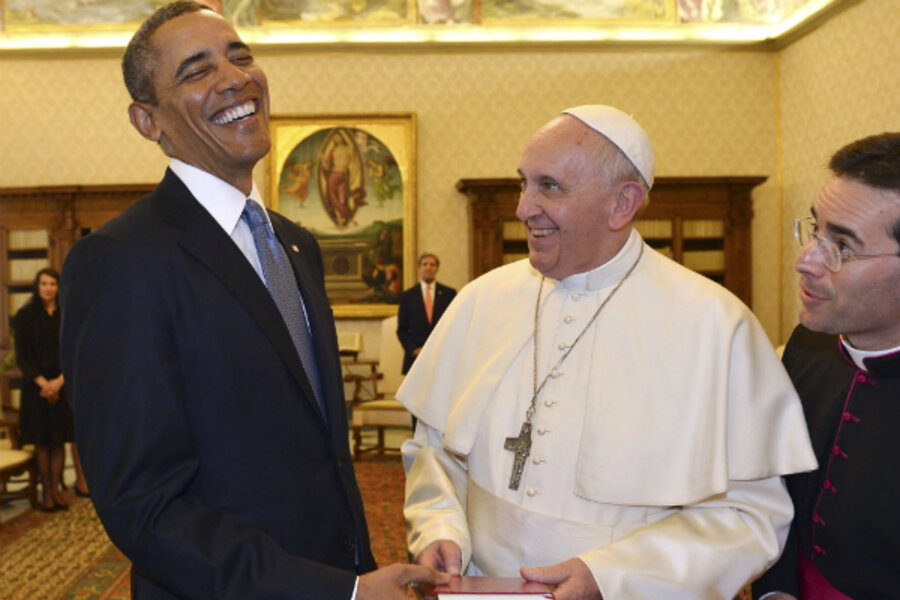Obama, Pope Francis, and the (rocky) history of US-Vatican relations
Loading...
President Obama met with Pope Francis for the first time on Thursday at the Vatican and appeared to enjoy the occasion. He and the pontiff exchanged a warm handshake, smiles, and nods when greeting each other outside the Papal Library in the Apostolic Palace.
“Wonderful meeting you,” Mr. Obama said. “Thank you, sir, thank you.”
Accompanied by interpreters, the pair moved inside the library and sat on opposite sides of the pope’s desk, according to a White House pool report.
“It is a great honor. I’m a great admirer. Thank you so much for receiving me,” said the US president.
Obama has good reason to enjoy a papal audience, of course. For one thing, he gets to associate with a world-renowned figure whose poll ratings are higher than his own.
Plus, parts of Pope Francis’s agenda mesh nicely with Obama’s political message for the 2014 US midterm elections. The pontiff has warned against the hubris of wealth and the dangers of ignoring the world’s poor and marginalized citizens. Obama and the Democrats, meanwhile, have been focusing on income inequality and the need to raise the US minimum wage.
But the course of US-Vatican relations has not always run smooth. For the White House, popes are not allies in a geopolitical sense, and they often talk about difficult issues, such as abortion or birth control.
This was reflected in differing readouts of the president-pontiff meeting provided afterward by the two sides. Obama said that he was “incredibly moved” by the discussion and that it centered largely on the problem of poverty. But a Vatican statement, issued shortly after the confab concluded, said it centered on questions of “particular relevance for the church in that country, such as the exercise of the rights to religious freedom, life, and conscientious objection."
The Roman Catholic Church has been concerned about the Obamacare mandate that health insurance must cover contraception – an issue currently before the US Supreme Court.
The difference in tone may be explained by the fact that Obama had discussions with other high-ranking Vatican officials about a wide range of topics.
What neither party to Thursday’s meeting said was that there were many years when US political leaders and Vatican officials had little or no official contact.
Beginning in the mid-1800s, America was swept with a wave of anti-Catholic sentiment. The Protestant majority felt threatened by rising numbers of Roman Catholic immigrants from Ireland, France, Italy, and Spain. The Know Nothing movement of the 1850s capitalized on this feeling by pushing to limit immigrant and Catholic influence in electoral politics.
In 1867, Congress passed a law prohibiting the use of US funds for US-Holy See relations. This produced an interregnum in diplomacy that lasted 74 years. President Franklin Roosevelt finally maneuvered around this anti-Catholic provision, sending a “personal envoy," Myron Taylor, to Rome to serve as an informal envoy to the pope.
President Harry Truman wanted to go further and appoint a full US ambassador to the Vatican but faced lingering opposition. Liberal icon Eleanor Roosevelt advised against it, on the grounds that it would violate the separation of church and state. Truman’s own pastor at Washington’s First Baptist Church preached from the pulpit against diplomatic recognition of the Vatican.
It took a shared enemy – communism – to finally bring the US and the Catholic Church back together in diplomatic terms, wrote Thomas Melady, a former US envoy to the Vatican, and Timothy Stebbins in a 2009 paper in “The Ambassadors Review.”
Pope John Paul II was the game-changer. President Ronald Reagan was impressed with John Paul’s support for Poland’s Solidarity labor movement and pushed for full US contacts with the Vatican. Thus, in 1984, a Protestant president who was a favorite of evangelical Christians obtained what Truman could not – Senate confirmation of a US ambassador to the Vatican, William Wilson.
Today one of the most visible diplomatic buildings in Washington is the Apostolic Nunciature of the Holy See, the equivalent of the Vatican’s embassy. It sits near the top of Embassy Row on Massachusetts Avenue, across from the entrance to the Naval Observatory, the official home of the US vice president.







